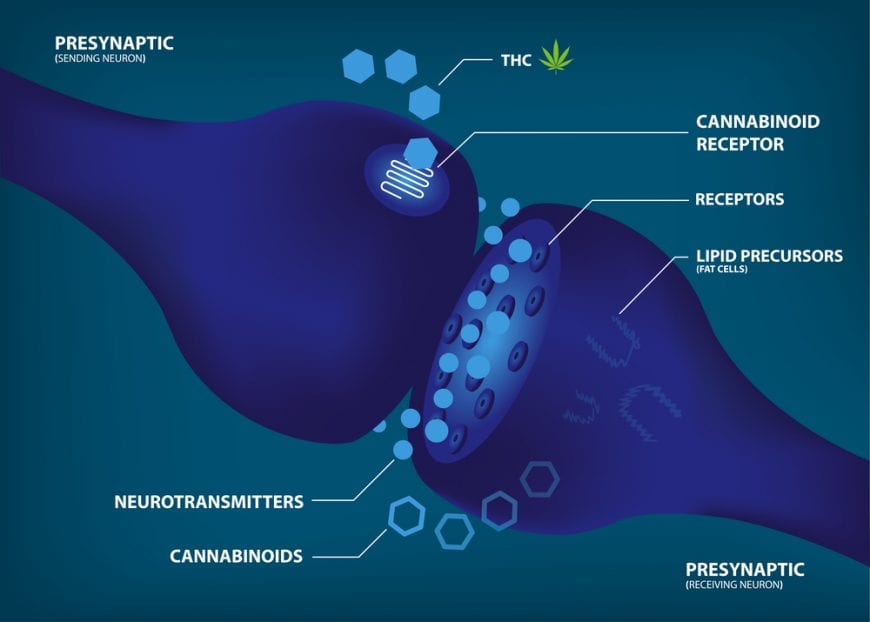Patients with neurodegenerative disease may have disturbances in their endocannabinoid system.
All neurodegenerative diseases have one thing in common – dysregulation of specific cellular processes: neurotransmission, oxidative stress, activation of immunomodulatory cells (called microglia), and maintaining proper rates of protein turnover in the brain and spinal cord tissue. Studies also show that the endocannabinoid system (ECS) changes in these diseases. Could cannabis therapy correct this?
Current therapeutic strategies for different neurodegenerative diseases, such as Alzheimer’s (AD), Parkinson’s (PD), Huntington’s disease (HD) and Amyotrophic Lateral Sclerosis (ALS) aim to improve symptoms like tremors, anxiety, and irritability. There is no pharmaceutical intent to reverse the neuropathology. There is no cure for these diseases.
Another Approach – Cannabis Therapy
What if there was a smarter approach? What if the “golden medicine” for these diseases would be something that repairs what is wrong at the cellular level and reverses the pathology? Research is trying to find out if this might be cannabis.
The common feature of AD, PD, HD and ALS is the progressive loss of specific neuronal populations in the brain and the spinal cord. This neurotoxicity results from several mechanisms.

Endocannabinoid System Malfunctions in Neurodegenerative Disease
Interestingly, the ECS balances in the post-mortem brains of AD, PD and HD patients. For Alzheimer’s, there is a downregulation (meaning a decrease in the number of CB receptors) in the areas of neuroinflammation and A-beta plaques. Alternatively, there are areas of upregulation (higher volume of CB receptors). These appear in segments of the brain that do not have plaques. Parkinson’s patients have similar changes in regulation of ECS.
In Huntington’s, there are less CB1 receptors in the brain, while CB2 receptors are increased for the areas of neuronal loss. Although HD is a genetic disease, caused by mutation in the gene encoding protein Huntington, cannabinoids act as neuroprotective agents for HD patients.
How Might Cannabinoids Help Neurodegenerative Disease?
In preclinical studies, it has been shown that regular administration of CBD or combination of both CBD and THC reduced the cognitive impairment in two different mouse models for Alzheimer’s.
THC has also been found to directly interact with A-beta, preventing its aggregation . Furthermore, the activation of CB1 and CB2 receptors gives protection against neuroinflammation and has detoxifying effect by reducing oxidative stress. The latter is another mode by which cannabinoids can treat neurodegenerative disease.

Since abnormal dopamine neurotransmission characterizes Parkinson’s, therapies increasing dopamine are beneficial. Blocking CB1 receptors enhances dopaminergic transmission, making cannabis a promising area of research.
THCV Therapy
At low doses, THCV has therapeutic benefit in rat models of Parkinson’s. THCV activates CB2, while blocking CB1. It also appears to have antioxidant properties, at least in cellular and rodent models. Similarly, THC and CBD restored dopamine levels in another study.
Additionally, CBG stopped the loss of dopamine neurons in a mouse model by decreasing inflammation. CBG is also therapeutic in HD, as was CBD. It has been suggested that the effects of CBD and CBG in HD are independent of their actions on CB1 and CB2, and that their action is through other receptors. Finally, Sativex ®, a 1:1 mixture of THC and CBD preserves neurons in HD animal models.
Neurodegenerative diseases differ in terms of which neuronal populations they degenerate. Still, these have almost all of the hallmark neuropathologies in common, all of which cannabinoids help.
Similarly, each neurodegenerative disease has a unique alteration in ECS. We should take these into account when designing cannabis therapy. For example, a potential winning strategy for AD would be a 1:1 combination of THC and CBD because it has been shown that administration of both is more effective and because of the fact that CBD counters the psychotropic properties of THC. Researchers expect patients to tolerate the therapy well.
Huntington’s Disease Too
We could employ a similar strategy for Huntington’s Disease. And, also CBD and CBG, as they show promising anti-inflammatory and antioxidant properties for HD. In Parkinson’s, targeting CB2 receptors might be most beneficial. THCV is thus an attractive candidate because of its ability to block CB1 and activate CB2 at the same time.
In the end, the ability of cannabinoids and cannabis therapy to restore the cellular processes that change in neurodegenerative disease is exciting and promising. More importantly, such approach would arguably have more chance in curing the diseases, as opposed to just relieving the symptoms.





